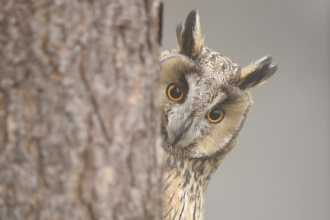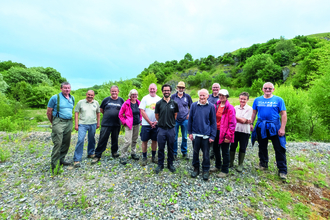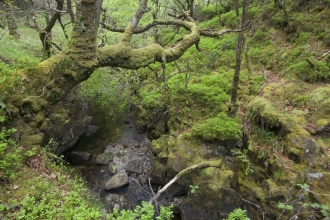By using this traditional method of planting a tree nursery, the mechanised element is removed which reduces carbon emissions as well as making the whole nursery working environment more enjoyable. This particular method of planting also allows for the trees to be planted upright with the roots trained vertically, preventing them developing into “J” or hockey stick shaped roots which commonly occurs with mechanised planting. Board planting is more accessible than mechanised planting as it can be used in areas that are not accessible by vehicles and is ideal for establishing small scale tree nurseries such as our newly created one at Aberduna in Maeshafn by the Woodlands for Water Project.
Tree nursery creation using a traditional lining-out Board planting system
Board Planting _ NWWT Sarah Ellis
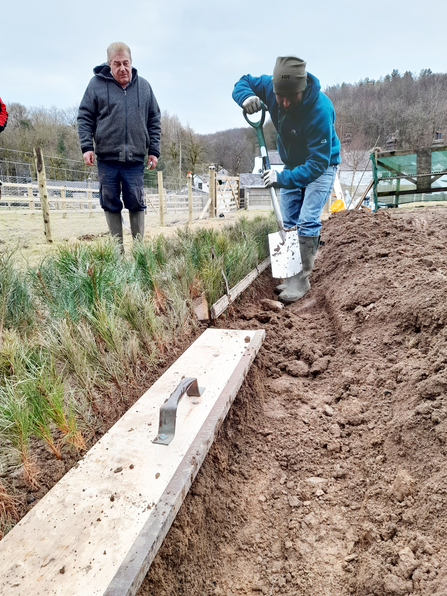
Jonny Hulson (right) learning the lining-out board planting system from Gary Bailey (left) © NWWT Sarah Ellis
The Woodlands for Water Project team came to learn of this new technique whilst on a visit to Prees Heath Forest Nurseries in Whitchurch, where NWWT have been sourcing tree stock for community planting projects for many years. We were invited by David Gwillam (Owner/Director - Prees Heath Forest Nurseries) and Gary Bailey who has recently retired from working as a planter at Prees Heath, and is the last person to have planted trees using this method in the UK since the early 1970s. It’s been estimated that Gary has planted over 7 million trees in this way over his 25 years working at Prees Heath! The Woodlands for Water Project team were so inspired by the board planting method, we invited him over to Maeshafn to train up our staff and volunteers in the Spring of 2021.
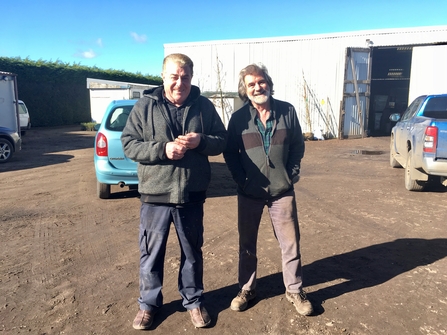
Gary Bailey (left) and David Gwillam (right) _ NWWT Jonny Hulson
All tools used for board planting are designed to optimise efficient working. This includes the filling frame which is designed at an ergonomic working height for sorting the trees to be planted. The frame is covered on three sides with a mesh screen which is designed to protect the bare roots from the wind and the sun which would dry them out.
On the frame sits the notched distancing board. This is a strip of rubber with notches cut into it at 2 inch spacing, which is then used as a guide for spacing the trees in lining them out.

Alison Earlam Loading the trees in the lining-out board _NWWT Sarah Ellis
The notched distancing board is used with the lining out board which is used to carry 40 to 50 trees to their nursery bed. This is made from two separate boards which are held together with a peg that clamps together with soft rubber in-between them to grip the trees all at once without damaging them.
For preparing the ground for the trees in the lining out board, a stamping/distancing board is used. This board is the same length as the lining out board and has a metal edge to prevent damage to the board when using the flat backed spade along the edge.

Volunteers Gareth Jones (left) and Rhiannon Bartly (right) planting using the lining-out board planting system © NWWT Sarah Ellis
Before planting the trees, the ground needs to be prepared and protected from livestock and rabbits. For the site used by the North Wales Wildlife Trust, which was formally grazed pasture and required rabbit proof fencing to protect the trees from being grazed. The turf layer of grass was removed to expose the soil which was then rotavated to an eight-inch depth to make the soil light and soft to work with. This is done to make the digging more ergonomically efficient to work with, as this saves time not having to dig through heavy and compacted soil.
The planting is done through late autumn, winter and early spring. Weeding is required between the rows through the summer months as well as watering with a sprinkler system during periods of drought.
Depending on the species planted and their root growth rate, they are either lifted in the winter months for planting on projects facilitated through the Woodlands for Water Project, or potted on for selling locally to bring in extra funds to sustain the project into the longer term.
If you would like to know more about what we do on the Woodlands for Water Project or would like to get involved with our volunteering opportunities then please visit our website.
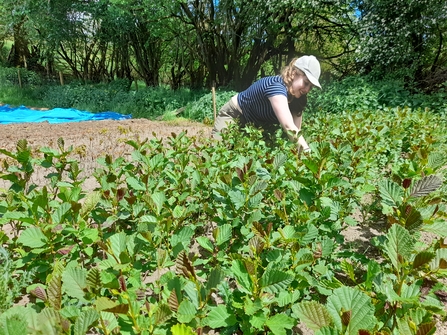
Becca Spurdle weeding between the rows of trees for maintaining the tree nursery _ NWWT Sarah Ellis


